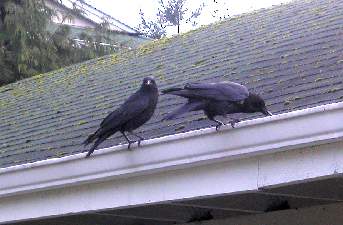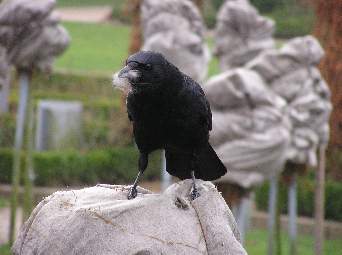|
|
Like the raven, the crow is a bird which appears in world mythology as a
soothsayer, an omen of death and as a creator and cleanser, taking away
all that was decayed. Full of intelligence, cunning, and playfulness,
the crow was seen as a guardian of the sacred alw among the tribes of
North America, a creature whose far-seeing eye saw past, present, and
future all at once. For the Algonquin peoples, Crow was the bringer of
grains and beans. In the Ghost Dances, which are danced to solicit the
help of their ancestors, Crow is a primary spirit messenger. Crows and ravens have an intricate and detailed history in Celtic lore and legend. The Irish battle goddesses, Morrigan and Badbh, regulary took the shape of crows, and both crows and ravens were their allies and companions. In Scottish folklore, the crow is said to have 27 different cries (a magical 3 times 9), each of which relates to a different event. These oracular cries can foretell the coming of important guests, an impending loss or death, or the coming of good fortune, a complete body of lore was built up from listening to the varied calls of the crows, which has the ability to mimic many kinds of sounds as well as to communicate with its own kind. When there is a molmacha (flock of crows), all crying together, it is said that no one but the most wise seer in the land can understand their words. In Greece, the crow was an unlucky sign. Although they were sacred to the goddess Athena, she would not allow them to perch upon the roof of the Acropolis in Athens, for most people believed crows to be an omen of death if they landed upon a roof. However, this did not stop Apollo shapeshifting into the form of a crow when he was fleeing from Typhon. In China, the three-legged crow lives in the heart of the sun and his three legs represent the morning, afternoon, and evening. A similar symbolism is found in Japan where the crow is often shown in front of the sun. The medieval bestiaries looked upon the crow as a bird of parental devotion. It was also believed that crows led the migtration of the storks. Confusingly, medieval Christian belief held that the crow was both a sign of the devil because of its scavenging behavior and a symbol of fidelity, since it was believed that crows did not seek a new mate if their own partner died. The magical properties of the crow include an ability to divine the future and to dismantle the past, as well as to teach human beings how to mix love, humor, and playfulness. A picture of two crows in ancient Egypt symbolized married happiness; for the Aryan cultures the meaning was the same along with the idea of food and fertility. To the Hindus, the crow was the emblem of the god Varuna. |

"I'll keep lookout while you see what you can find in there". Picture of two busy crows on a roof.
Crow intelligence
As group, Crows demonstrate admirable examples of intelligence and they are considered by many to be the most intelligent birds. They seem to show signs of planning and communication between individuals. One of their species, the New Caledonian Crow (Corvus moneduloides), has recently been studied intensively regarding its ability to make and to use its own tools to obtain its food. It creates hooks from plant materials, and uses these self-made tools to skilfully remove grubs from logs. Crows can count slightly. For example if three people enter a bird observation hut and two then leave, they know that the hut is not empty. Crows can learn to speak words and short sentences even clearer than parrots.All crows have the interesting habit of collecting and hiding away bright objects that they do not seem to have any particular use of, apart from their attraction to the object's brilliance. Despite their remarkable abilities though, Crows and Ravens are very rarely kept as pets or domestic animals. This may be partly due to their mischievousness, which can be annoying.

Photo of Crow on a railway water pipe.
Crow Legends and Mythology
The remarkable Crows and Ravens have roles in legends and myths worldwide. Their wisdom, intelligence and flying powers were used by Ancient Gods and Kings. These birds and superstitions surrounding them also played a role in the day-to-day lives of people. In the Nordic mythology the Raven symbolizes wisdom. The God Odin had two Ravens called Hugin and Munin who flew around gathering news of happenings in the world, and sat on the God's shoulders telling him of what they had seen. The Greek God Apollo considered the Raven to be a sacred bird.King Arthur of the English tale of Camelot and the Round Table was said to have not died but have been transformed by magic into a Raven or Crow, although other stories, particularly in Cornwall say Arthur was turned into a Chough or a Puffin. Legend says that if all the living Ravens leave the Tower of London, a catastrophic end will come to the English monarchy, and the Tower of London will fall. The "Beefeaters" who run the Tower therefore keep a group of Ravens there - just in case!

"This will be nice for the nest". Picture of a Crow who has found some fluffy feathery material.
Crow
Birds of the Corvus genus
The name Crow is in nearly all european languages a name which graphically mimics the typical cries of these birds. For example, the modern german name is word is "Krähe". In Holland the Crow is "Kraai", and in French it is "Corbeau".
The Corvidae family is sometimes referred to as the crow family, but the true Crows are birds of the Corvus genus which is just one particular genus within the Corvidae family. Within this genus there are around 42 species.The larger representatives of the corvus genus are the Ravens, the smaller ones are Crows, and among the very smallest are the Jackdaws. The Rook is also a member of the corvus genus and can be distinguished from the Crows and other fellow members of this genus by the existence of an area of bare grey-white skin around the base of the bill of the adult Rook, in front of the bird's eyes. In addition the feathers around the Rook's legs appear a little more ruffled than those of the Crow.
The crows have a large geographic distribution. All the temperate zones of all continents (with the strange exception of South America) and many oceanic islands including Hawaii have representatives of members of the Corvus genus. The crows seem to have evolved in central Asia and soon to have extended their territory to North America (including Mexico), Africa, Europe and Australia.
The beak of the crow is thick and strong, the top being slightly downwardly curved and with a narrow point. The wings are quite long, with narrow, pointed feathers.
Some species form large colonies with a complex social structure. Usually they form monogamous couples.
The nest is built in high treetops or in hollow trees. All species of Crow build simple and uncomplicated nests which are quite shallow, made of sticks and twigs, intermixed with mud. A ball made of a variety of soft matter is included in the nest for padding. Usually between three and seven eggs are laid. Once hatched, male and female crows are equal in appearance. After their first year the young birds attain their full adult plumage.
Crows are very resourceful creatures. 19th Century ornithologist, A. Newton wrote of how in "British India", in any lengthened camp settlement or station that was established, House Crows (Corvus splendens) would build their nests from the wire from the Englishman's soda-water bottles, and that these crows were so used to humans that the crows would dispute for meat from the fires with both Kites and cooks.
Crows are actually omnivorous and their natural food includes small invertebrates, fruits and seeds. The Fish-Crow (Corvus ossifragus) of the USA, deserves spcial mention as it has a particularity toward shrimps and fish as well as crabs and other crustaceans, although will also eat other food like fruit, grains, peanuts and small reptiles, and even small nestlings belonging to other types of bird. Other crow species may sometimes also feed on fish which have been thrown ashore by the sea although these others will rarely draw fish from the waters themselves.
In flight the Crow is steady and straight. On the ground these birds tend to hop rather than run, which gives them a rather amusing bouncy appearance.
Δεν υπάρχουν σχόλια:
Δημοσίευση σχολίου